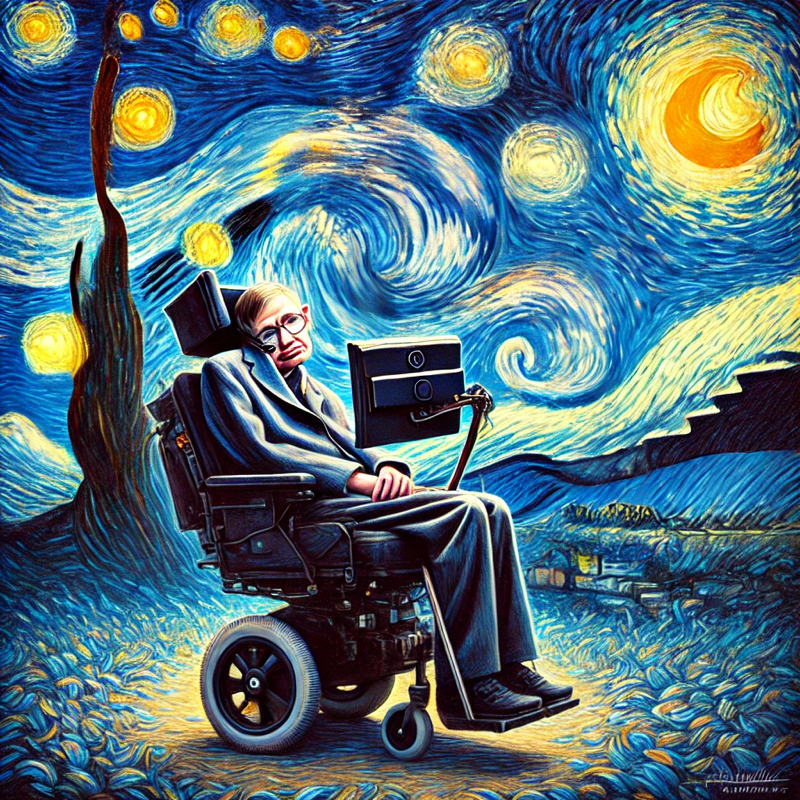Stephen Hawking: Defying Limitations and Redefining Possibilities
Stephen Hawking defied physical limitations to reshape our understanding of the universe. Despite societal biases and accessibility challenges, he adapted, persevered, and redefined perceptions of ability. His life teaches us resilience, adaptation, and the limitless power of the human mind.

Introduction
Stephen Hawking was one of the most brilliant minds of the 20th and 21st centuries, contributing groundbreaking insights into black holes, quantum mechanics, and cosmology. Despite his towering intellect, much of the public conversation about him was often dominated by his physical condition—amyotrophic lateral sclerosis (ALS), a neurodegenerative disease that gradually paralyzed him. While his scientific genius was undeniable, he also faced immense societal challenges stemming from misconceptions, biases, and assumptions about disability. His life was not just a testament to intellectual brilliance but also an enduring struggle against the limiting perceptions imposed by the world around him.
The Barriers He Faced
When Hawking was diagnosed with ALS at the age of 21, doctors gave him only a few years to live. However, he went on to defy medical expectations, surviving for over five decades. Yet, his longevity came with significant challenges, particularly in how others perceived and treated him.
The first challenge was the general societal attitude toward physical disability. In the scientific community—where sharp intellect, verbal dexterity, and active participation in discussions were highly valued—his deteriorating physical condition made it difficult for some to take him seriously. As his ability to speak declined, so did many people’s patience in listening to him, reinforcing the harmful assumption that a loss of bodily function equated to a loss of mental acuity.
Hawking also struggled with the patronizing sympathy often extended to disabled individuals, where well-meaning but misguided individuals reduced him to an object of pity rather than respecting him as an independent person. The media frequently focused on his condition rather than his achievements, framing his successes as inspirational primarily because of his physical limitations, rather than acknowledging the depth of his scientific work on its own merit.
Beyond public perception, the practical barriers he faced were immense. As his mobility decreased, accessibility issues became more pronounced. His reliance on a speech-generating device made everyday conversations, professional interactions, and even simple social engagements far more complicated. Many would assume that because he could not express himself quickly, he did not have much to say—a damaging assumption for a man whose ideas revolutionized physics.
How He Handled It
Rather than allowing himself to be defined by his physical limitations, Hawking made the conscious choice to focus on his mind, embracing technology as a means of overcoming communication barriers. His famous speech synthesizer, initially slow and cumbersome, became an integral part of his identity. Instead of lamenting the challenges of the disease, he found ways to adapt, modifying his approach to life and work rather than resisting the inevitable changes.
Hawking refused to retreat from the public eye, actively engaging in interviews, public lectures, and even popular culture appearances. Whether it was his guest spots on The Simpsons and Star Trek or his bestselling book A Brief History of Time, he made complex scientific ideas accessible to a broad audience. His presence in popular media challenged perceptions of disability, showing that physical limitations did not equate to a lack of wit, humor, or charisma.
Furthermore, he used his platform to advocate for scientific inquiry, disability rights, and even space exploration. He continued working at Cambridge, mentoring students, publishing research papers, and engaging with the scientific community as an equal rather than as an exception.
Lessons We Can Learn
Hawking’s life offers profound lessons for how we perceive limitations and human potential. Some key takeaways include:
- The Mind is Limitless
Hawking proved that even when the body fails, the mind can continue to push boundaries. Intellectual capability is not determined by physical ability, and we must ensure that biases do not exclude people from meaningful contributions. - Adaptation is a Form of Strength
Many view physical decline as the end of personal growth, but Hawking embraced adaptation as a tool for progress. His use of assistive technology was not just about survival but about thriving in his field. - Resilience in the Face of Misconceptions
He faced skepticism and misunderstanding, but he never let them dictate his self-worth. His determination to persist in academia despite the odds serves as an example of self-belief and perseverance. - Redefining Representation
By being in the public eye, Hawking reshaped how society viewed disabled individuals. He was not just a “disabled scientist”—he was a great scientist, period. - Humor and Optimism as Tools for Survival
Instead of becoming embittered by his condition, he often responded with humor, showing that life’s adversities do not have to define one’s outlook.
Conclusion
Stephen Hawking’s legacy is twofold: his scientific discoveries reshaped our understanding of the universe, and his life’s journey redefined societal attitudes toward physical limitations. While he undoubtedly faced bias, skepticism, and countless barriers, he refused to let them dictate the scope of his aspirations. His story is not just about scientific genius; it is about the relentless pursuit of knowledge in the face of adversity. More importantly, it challenges us to rethink how we perceive ability, intelligence, and human potential.
In a world that still struggles with ingrained biases, Hawking’s life reminds us that true brilliance is not confined by the constraints of the body, but rather by the limits we impose on ourselves and others. His story is not just an inspiration but a call to dismantle outdated perceptions and create a more inclusive world—one where every mind is given the space to shine.
